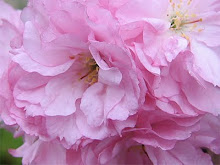
My topic for this very first issue of "MACRO TALK" is which macrobiotic web sites or blogs do I think give a better-than typical answer to the question, "What is macrobiotics?" By typical, I mean just giving a dictionary's definition of the word "macrobiotics" — big or large for "macro" and life for "bios" — without saying anything more about it. So...
What is Macrobiotics?
• Leslie at Macro808.blogspot.com (Naturally!) gave a really good answer in a February 9, 2005 posting that is worthy of inclusion here.
She begins by saying, "Someone left a comment asking, 'What is macrobiotics, anyway?' It is good practice for me to try and answer this question. To me, 'macrobiotic' means several things. From my experience, it is a diet, a philosophy, and a lifestyle."
And then she continues to do a really good job of explaining her statement. In fact, I thought her answer was so good that I decided to read the whole rest of the blog all the way up to the present day!
• From Leslie's Naturally! blog, I followed a link to Hawaiian Chef and Restaurateur, Alan Wong, and watched an interesting video of him explaining their "Farmer Series Dinner." What a great idea! To interact with the farmer from field to dining table... I like it.
Back to looking for people's better-than-typical answers to the question, "What is macrobiotics?"...
• Sharlene at "Macrobiotics and Me" has a wonderful blog dedicated to macrobiotics. She says in answer to the question, "What is macrobiotics?":
"For me, macrobiotics is so many things but essentially it is about reaching our full potential in life. It’s about becoming more balanced in all areas of our lives and gaining insights into one’s health (and when I talk about health I mean it in a holistic sense so that includes everything about a person basically – mental, emotional, spiritual, energetic and physical). It’s also about understanding how the universe operates, the natural laws and eating and living according to all of this."
Sharlene's macrobiotic blog continues to give a unique overview of how one person chooses to eat and live while practicing macrobiotics. Very enlightening. She also provides some interesting links to other macrobiotic web sites, including the following link:
• The International Macrobiotic School in the U.K. where they provide professional training courses and a Cookery Class Programme.
"What is Macrobiotics? ...Macrobiotics is an art of life in which you become more and more conscious.... conscious of the responsibility you have to give your life shape. The search for our deep nature is the first step in the greater search for our true self. Who am I? What am I doing here in this lifetime?" — Marijke De Coninck, What is Macrobiotics?
• The web site, "The Macrobiotic Guide," founded by James W. Trevana, says this in answer to the question, "What is Macrobiotics?":
"Macrobiotics is an approach to physical and emotional wellness through consuming foods that are balanced energetically (between yin and yang) and nutritionally. It is typically a well-balanced diet with high fibre, low fat, lots of vegetables and grains, vegetable protein, and limited meat, with an emphasis on eating seasonal organic food."
The web site is a collection of macrobiotic information written by different people. They have a special features section called "What People Say About Macrobiotics" that is a drop-down list of about a hundred people's names, linking to articles interviewing them. Each article asks them questions like, "How did you start macrobiotics?" and "How has macrobiotics helped you?"
A lot to talk about. A lot to think about. Much food for thought!
Related blog articles:
What Is Macrobiotics? (January 2, 2011)
What Is Macrobiotics? (January 23, 2011)
Lessons From A Coyote (March 8, 2011)
































































